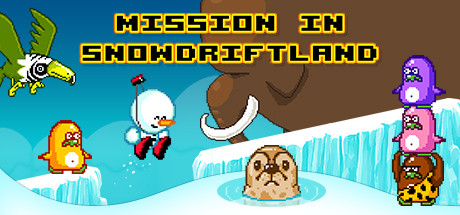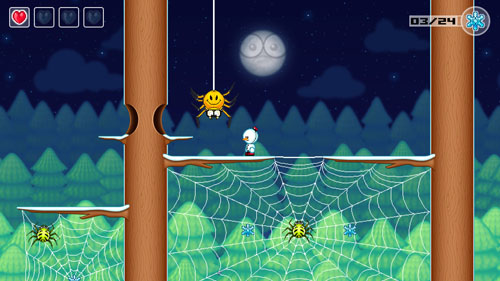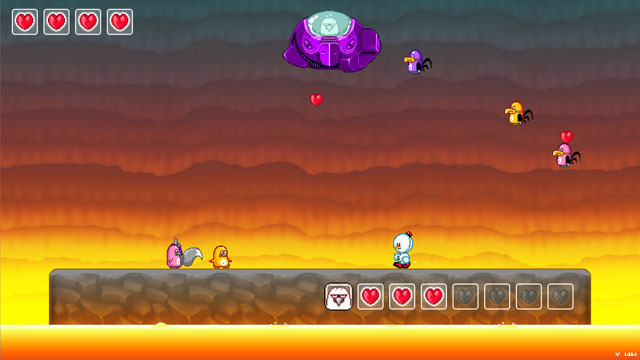A game by Extra Toxic for browser, originally released in 2006, and remastered by Tons of Bits for PC in 2021, and released for Switch in 2024.
The mid-2000’s were something of a transformative period for Nintendo, with the launch of the Nintendo DS in 2004 and the Wii in 2006. The Nintendo DS represented yet another handheld console success for the company, while the Wii reignited the fires of Nintendo’s home console popularity after being overshadowed (yet still profitable) for the previous two generations. This part of Nintendo’s history is much discussed and very well documented, but less well known are the adventures of a certain snowman named Chubby.In 2006, to celebrate their new systems and upcoming games, Nintendo offered a playable advent calendar entitled UPIXO in Action: Mission in Snowdriftland, with one level available for play each day from December 1-24, counting down the days to Christmas. The Flash-based game was a platformer starring a snowman named Chubby Snow who wore red shoes and a bellboy cap. Chubby traveled through four (mostly snowy) themed areas bopping enemies on the head, collecting snowflakes, and searching for hidden hearts that permanently extended his life meter.
Alongside each level of the game was an advertisement for one of the titles coming to Nintendo’s platforms during that holiday period. Completing levels would unlock extras for some of these games, including wallpapers, desktop icons, and ringtones. But the game had a limited lifespan… it was only available to play until January 16, 2007 (delayed from January 14), after which time, it was taken offline.
While the game was presented by Nintendo, it was actually developed by a German web developer called Extra Toxic, and that studio retains the rights to the game and its assets. Steve Welz developed a Flash-based platforming engine that offered something of a step up compared to the droves of mediocre Flash-based games in the day. Interestingly, rather than preparing all 24 levels in advance, the Extra Toxic team was developing new levels during the course of the December 2006 promotion window. Later, in December of 2010, the studio brought the game back for another limited release, this time showcasing indie games available on WiiWare.
In 2018, years after the game was thought to have been lost to time, someone discovered that it was actually still playable via Extra Toxic’s media page, albeit unintentionally. In 2020, thanks to an interview with Steve Welz by documentarian Nick Robinson*, the game received renewed interest from the original developers for a modern-day port that did not rely on Flash. The timing was fortuitous given that Flash support was planned to be eliminated from browsers at the end of 2020, which would once again render the game unplayable for most people.
The remastered version of the game is entitled Mission in Snowdriftland, and it includes the 24 levels from the original game and the final boss battle, presented in widescreen HD at 60fps, with all of the Nintendo-owned assets removed (for obvious reasons). The story centers around a villain named El Pix who has stolen important video game artifacts from a company called UPIXO (United Pixelheroes Organization). You take on the role of Chubby – a struggling video game character who is disappointed as his minor roles in past games – as he sets out across the Snowdriftland to retrieve these artifacts.
As a platforming hero, Chubby’s primary ability is his jump, and he has a very high variable jump, allowing him to cross gaps, reach higher platforms, and bop most enemies on the head to kill them. He is also able to duck, climb spider webs, and slide down sloped surfaces, allowing him to kill enemies by sliding into them. Chubby has a fair amount of inertia – combined with the fact that he deals with a lot of icy surfaces – which means that it takes some effort for him to get up to speed. Furthermore, Chubby has two different running speeds, as he breaks into a sprint after running in a straight line for a few seconds without hitting anything, and he can also build up speed more quickly by running down slopes.
While this highly variable speed does mean that the player has a lot of ways to deal with the environment and enemies, it ultimately creates somewhat unpredictable movement, making it more difficult to line up jumps and make precision landings. Enemies – most of which are penguins, which humorously don other animal disguises for non-snowy levels – tend to be tall and thin, making it more difficult to land a deathly head-bop.
There are no checkpoints, so levels must be repeated from the beginning if the player is killed, but the game offers infinite continues. Levels are fairly short, designed to be completed in about a minute each if the player simply wants to make it from one end of the level to the other, but there is a secondary objective in each level, which is to collect all 24 snowflakes. Early on, these snowflakes are generally placed along the primary route through the level and require only a bit of extra effort to collect, but their placement becomes more challenging in later levels, ultimately making their collection an optional challenge for skilled players. Collecting all 24 snowflakes in all 24 levels (that’s 576 snowflakes in all) unlocks a bonus level.
Merely completing each level can be somewhat challenging, but platforming veterans can expect their skills to see them through to the end of the game. Collecting snowflakes, on the other hand, requires more advanced techniques and a higher degree of skill, and this is an all-or-nothing effort… collecting 23 snowflakes in a level does nothing. The lack of checkpoints can add some frustration for players who put a lot of effort into collecting hard-to-reach snowflakes only to be killed and forced to repeat the challenge. That said, players who do fully explore the environment in search of snowflakes will discover heart containers hidden throughout the game (one in each themed area), each of which permanently extends the player’s default 3-heart meter by one (the original game started the player with a 2-heart meter).
The game world is divided into four biomes which are visible from a world map that is set up like an advent calendar, with doors opening to each of the 24 levels as a countdown to Christmas, and these levels must be completed in order. Things start out on an icy lake before moving to a snowy forest, rocky mountains, and volcanic caves. Strangely, the first area is one of the game’s toughest, as there are numerous patches of icy water that kill the player instantly when he falls in.
The first area also introduces sheets of ice that shift back and forth with the player’s movement to create slopes that affect his movement speed, along with slippery sloped surfaces that cause the player to slide while standing still and narrow sloped surfaces that require the player to steady himself to keep from sliding off. These are the kinds of platforming elements that are typically saved for later in a game once the player has mastered the basic controls, but here they’re presented right up front.
The second area takes place in a forest and offers a largely orthogonal design, with the player travelling along mostly flat surfaces. This area is also more structurally interesting, with more verticality and more exploration required to find all of the snowflakes. Here, you’ll be jumping up through tree branches, fighting penguins dressed as squirrels, avoiding rampaging tree monsters, climbing the occasional spider web, and trampolining off the back of creepy snowman-creatures that scurry along the ground.
The third area takes place in the mountains and is once again heavily snow themed (this is Snowdriftland after all), but it still doesn’t have as many insta-death traps as the first area, nor as many tilting platforms, making it arguably easier than the first few levels of the game. This area allows you to make more use of your butt-slide maneuver to speed down slopes and take out penguins who are wearing bird costumes here, allowing them to make very small flights with a great deal of effort.
This area features frozen spiked objects that hurt you if you touch them (even on their non-spiked bottoms), huge mammoths that you can ride on top of, moving cloud platforms, and swooping vultures. There are also lots of stalagmites that hurt if you land on their tips. These aren’t difficult on their own but they are very similar in color to the background, sometimes making them hard to spot (especially the little ones).
The final area pulls out all the stops by mixing in elements from the previous areas and mashing them together in more dastardly configurations, requiring the player to make use of all of his skills. There are more invincible enemies - such as fireballs, spiders, and scorpions - requiring that the player avoid many encounters, while also dealing with tilting platforms, sinking platforms, and huge pools of lava. Moving fireballs make some areas particularly challenging, as taking damage in midair saps most of your forward movement, so hitting a fireball while jumping often means falling into the lava below.
After completing all 24 levels, the player faces off against El Pix himself, who flies around in a hovering purple ship. The ship repeats a couple of basic patterns, first flying overhead to drop off enemies, then swooping quickly across the screen to give you a chance to bop it and cause damage (you can bounce off enemies to increase your jump height and make it easier to land this attack), then descending slowly to give you an easier opportunity to attack. This pattern repeats as you wear down the ship’s health meter, with El Pix dropping tougher enemies along the way, eventually including scorpions that cannot be killed.
The game is presented in a retro style with a high resolution, offering chunky yet detailed enemies. Reaching the end of each level unlocks an artifact from the world of gaming, such as a tetromino, a “hedgehog ring”, and a breakable brick, each offered with a humorous quip from a guy in a lab coat as he makes references to the associated video game classics. These artifacts are collected in a huge lab with an observation capsule assigned to each. The lab also shows the total number of snowflakes collected, and there is an indicator on each door of the advent calendar displaying whether or not every snowflake has been collected within that level. In the game's original release, these rewards came in the form of downloadable bonuses associated with titles appearing on Nintendo's platforms.
The game’s front-loaded difficulty and lack of checkpoints is out of place in the context of modern platformers – and even many classic platformers – but this design makes more sense when considering how the game was originally conceived. Rather than experiencing all of the levels as a single game played from beginning to end, the developers released one level per day, and players challenged themselves to complete these levels and collect the snowflakes within dedicated single-level play sessions. This would have tempered the frustration of spending 5-10 minutes (or more) replaying a level to locate and collect all of the snowflakes.
2D CRED
UPIXO in Action: Mission in Snowdriftland was developed by Extra Toxic, a studio founded in the summer of 2005 and based in Frankfurt am Main. The studio is primarily a web developer which has created the official European websites for several companies, including Nintendo, EA, Ubisoft, and Panasonic. Steve Welz is credited with the game’s programming and level design; Bogac Sariaydin is credited with the game’s design, graphics, and animation; and Christiane Fritsch is credited with Project Management and game text. Music and sound for the game were composed by Fabian Del Priore (a.k.a. Rapture), who has provided music for numerous games, including Gunlord X, Giana Sisters: Twisted Dreams, and Ghost Blade HD. The game was hosted by Nintendo.
Following this release, Extra Toxic went on to develop Chick Chick BOOM, which was also a limited-time release in cooperation with Nintendo as part of an Easter celebration in April of 2007, with an updated version of the game released for the Wii in 2010. Development for the remastered Mission in Snowdriftland was completed by a team called Tons of Bits, which is the game development label of Extra Toxic, headed by Bogac Sariaydin and Steve Welz.
*History for this article was derived mostly from Nick Robinson’s documentary entitled Mission in Snowdriftland: Nintendo's forgotten Flash game.
































0 comments:
Post a Comment